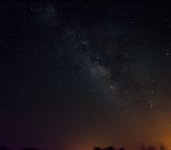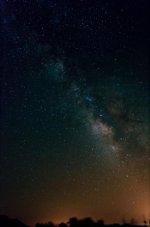My first ever attempt at photographing the Milky Way. These shots were taken north of Florence, AZ (source of light pollution) on a new moon night. The first square looking image was taken with a Nikon D5200, 18-55mm kit lens at 18mm and f/3.5 aperture, ISO 2000 and 20 sec exposure. This is a compilation of 15 exposures aligned and hot pixel removal in Deep Sky Stacker and stacked in Photoshop CS6. RAW images were processed in LightRoom 4 to correct for white balance, lens distortion, noise reduction, etc. The second vertical image was processed the same way except it was 6 exposures of 20 seconds taken at ISO 3200. Both exposures had a fair amount of noise and I think the 90 degree nighttime heat didn't help matters either. I was surprised how much more color I had in the ISO 3200 shots compared to ISO 2000.
Biggest lesson I learned is that to the naked eye the light pollution didn't look too bad but once exposed - wow - is it obtrusive. I'm pretty happy with the results considering this is the cheap kit lens. I really want a faster/wider lens now....
Oh, one other thought, focusing was a challenge even with highest ISO and zoomed in with Live View. I just focused on illuminated cactus as far as flashlight would reach and took a few high ISO test exposures to make sure it looked OK but I still don't feel as though it was as well focused as it could be.... Maybe a faster lens would make focusing on bright stars possible.
Any feedback would be appreciated - good, bad or otherwise. Full resolution version are on my Flickr page.
Biggest lesson I learned is that to the naked eye the light pollution didn't look too bad but once exposed - wow - is it obtrusive. I'm pretty happy with the results considering this is the cheap kit lens. I really want a faster/wider lens now....
Oh, one other thought, focusing was a challenge even with highest ISO and zoomed in with Live View. I just focused on illuminated cactus as far as flashlight would reach and took a few high ISO test exposures to make sure it looked OK but I still don't feel as though it was as well focused as it could be.... Maybe a faster lens would make focusing on bright stars possible.
Any feedback would be appreciated - good, bad or otherwise. Full resolution version are on my Flickr page.


